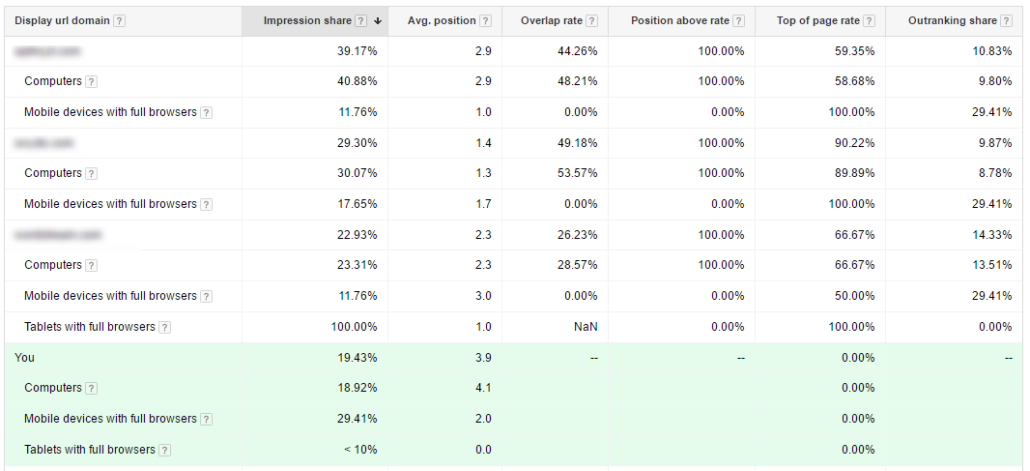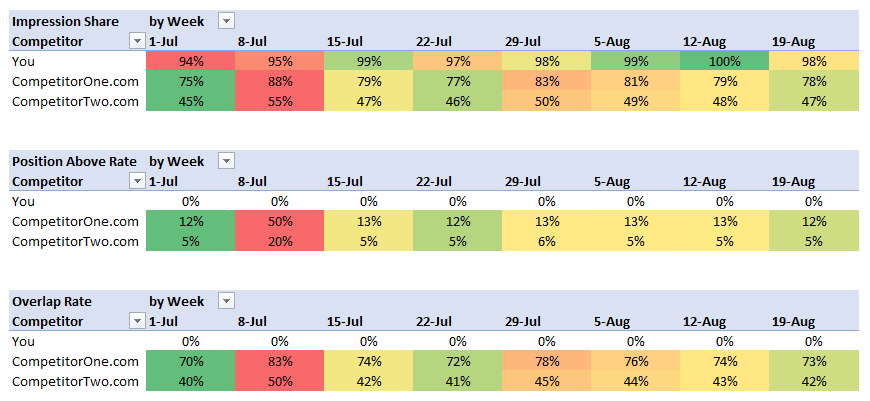You’ll often hear that a little healthy competition is a good thing for your business. It certainly doesn’t feel that way when you look at your Google Ads campaign and see your CPCs have almost tripled in the past week and you have no idea why. You might be scratching your head to see that nothing in your account has changed but your CPCs are higher than you’ve ever seen them.
It’s likely that you’ve seen an increase in competitive bidding behavior on your keywords but you might not know to what degree. Well, fortunately, Google provides great insight into how aggressive your competitors are on your campaigns. In this article, we’ll go into detail of how to access this data and how to interpret this information in a valuable way.
What is an Auction Insights Report?
The easiest way to evaluate competitive trends on your keywords is by using the Auction Insights report within Google Ads. This tool allows you to select campaigns, ad groups, or keywords and see exactly how your competitors are bidding on your keywords. Remember, this can only be done to keywords that you are currently bidding on. We also recommend when evaluating Auction Insights, that you do so on a very specific keyword with strong volume so the data isn’t muddied by match types and other keywords.
In the below screenshot, you’ll find a sample Auction Insights report from one of our client accounts (masked for anonymity). Please find brief definitions (per Google Ads) of each metric below:
- Impression Share is the number of impressions you received divided by the estimated number of impressions you were eligible to receive.
- Average Position is the average rank of the ad in the auctions, which determines the order of the ads on the search results page.
- Overlap Rate is how often another advertiser’s ad received an impression in the same auction that your ad also received an impression.
- Position Above Rate is how often the other participant’s ad was shown in a higher position than yours was when both of your ads were shown at the same time.
- Top of Page Rate tells you how often your ad (or the ad of another participant, depending on which row you’re viewing) was shown at the top of the page, above the unpaid search results.
- Top of Page Rate tells you how often your ad (or the ad of another participant, depending on which row you’re viewing) was shown at the absolute top of the page as the very first ad above the organic search results.
How to Evaluate an Auction Insights Report
If you’ve ever tried to review the Auction Insights report in Google Ads, you might find the dashboard format a little difficult to digest. Below you will find a screenshot from Google Ads that shows auction data segmented by device. While this view isn’t too bad to look at, if you wanted to segment by 10+ weeks, it would become quite challenging to pick out any trends efficiently in this cluttered format.
Auction Insights from Google Ads:
Therefore, we suggest reviewing Auction Insights in a different format, one that requires the data to be exported from Google Ads and manipulated via a Pivot Tablet (see below):
Auction Insights, Pivot Table format:
With the above format, you can glean insights quickly and apply conditional formatting to help you identify trends more efficiently. You’ll notice too that we’ve isolated each metric into their own pivot tables. We prefer this approach, as it appears less cluttered and makes the data easier to interpret.
There are a number of metrics you can look at when reviewing an Auction Insights report but we recommend limiting it to 3 metrics in the screenshot above. Impression Share indicates roughly how aggressive your competitors are on your terms. In this case, the week of July 8th shows that our competitors became more aggressive on our terms. Position Above Rate will tell you how often another advertiser in the auction is appearing above you. Judging from what we are seeing during the week of July 8th, it is safe to assume that our competitors started to bid much more aggressively on our terms. Lastly, overlap rate will show you how often an advertiser appears in the same search that one of your ads appeared it. This is valuable in determining if the increased presence of competitors appearing alongside us is having an impact on performance.
Other Competitor Analysis Tools
The Auction Insights report is the only first-party competitor analysis tool through Google Ads but there are third-party tools that also provide valuable insights. SpyFu and SEMRush are just two examples of competitor analysis tools we use to gather insights for our clients. Both tools provide similar features related to ad copy monitoring and keyword bidding insights. We often leverage these tools to gather keyword opportunities that we use for expansion in our accounts. That challenge we find with them is that they often have very broad lists of keywords, thousands of rows long, and it is a bit challenging to mine through them efficiently.
If you are interested in having our team dive into your competitor data, please contact us by email at sales@synapsesem.com or by phone at 781-591-0752.



